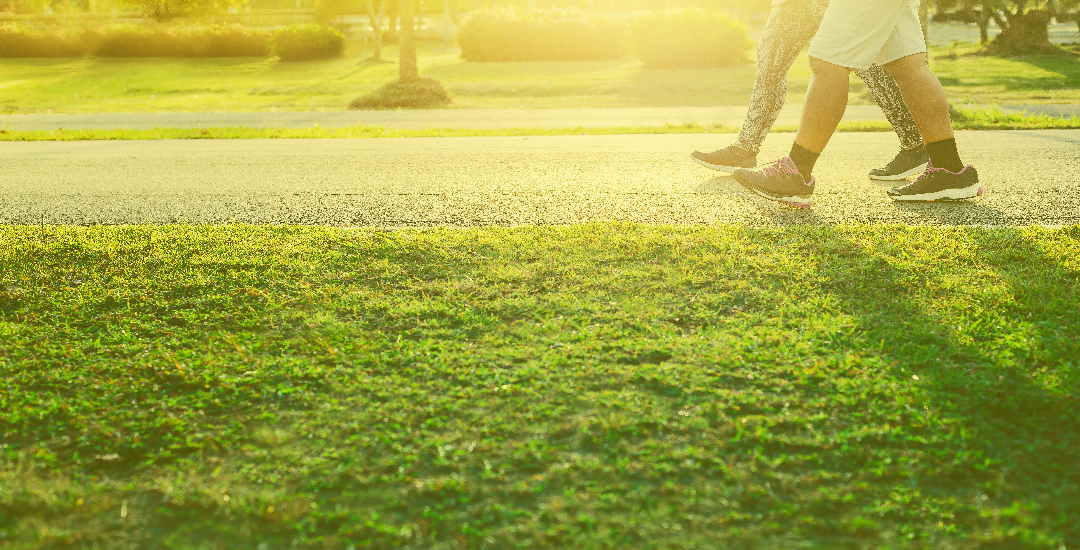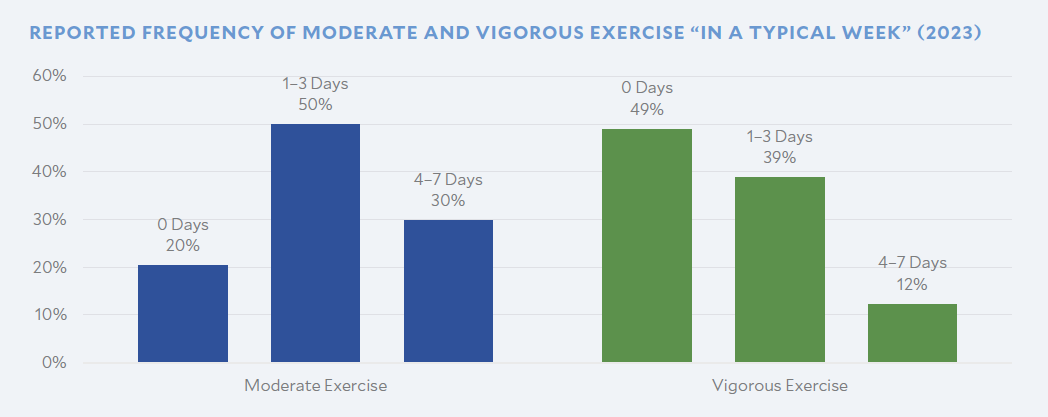This post is part of a series highlighting the findings from the 2023 Kinder Houston Area Survey.
Our built environment and lack of access to safe fitness spaces could be the most significant barrier to successfully exploiting the benefits of physical activity— not our lack of willpower.
Mayor Sylvester Turner’s public-private partnership initiative, the 50/50 Parks Partners, made great strides in driving park equity. These infrastructure investments bend the curve in favor of our city’s health. And yet, some communities with a desire to be physically active are held back by inequitable built environments with neighborhood characteristics that do not support active lifestyles.
The 2023 Houston Area Kinder Report revealed that one in five Houstonians reported no physical activity in a week. This demands our attention and a closer look at the reasons why 20% of our city has higher health risks due to inactivity.
Systems-level interventions that support physically active communities include strategies such as: urban design for walkable communities; Complete Streets policies; active transportation investments to reduce dependency on vehicles; park equity investments; and improving neighborhoods with equitable access to free outdoor gyms and safe trails—to name a few.
In parallel, micro-level interventions are needed to build community connections around physical activity through programs such as Safe Routes to School, community exercise groups, and other free programs to encourage a culture of health at the neighborhood level.
Infrastructure investments and policies coupled with city-wide ground-level health promotion within communities are key.
Sitting is the new smoking
If “sitting is the new smoking,” let’s move more. Moving more and sitting less throughout the day is imperative to our health and engaging in moderate-to-vigorous intensity physical activity daily can reduce cardiovascular and cancer risk and improve mental health. Exercise is a critical component to achieving and maintaining a healthy weight and ultimately preventing many chronic diseases.
Physical activity increases lean muscle mass, and this improves metabolism and body’s ability to burn calories at rest. In simple terms, physical activity falls into two overarching categories: cardio and strength training. “Cardio” is an activity that increases your heart rate and exercises your heart. Muscle strengthening exercises, such as resistance or light weightlifting, exercise all major muscle groups throughout the body.
Brisk walking 30 minutes for five days a week accumulates the recommended 150 minutes of moderate-intensity aerobic activity outlined in the evidenced-based Physical Activity Guidelines for Americans that recommend moderate or high-intensity muscle-strengthening exercise be practiced at least twice weekly for additional health benefits.
Walking is free, but unfortunately, the lack of access to safe streets and sidewalks, low perceived safety, and low social cohesion can make this daily goal challenging. A brisk walk or stroll around your home or place of work is the easiest way to get your daily steps, but this is out of reach for far too many Houstonians and requires driving, parking, or accessing a treadmill.
Houston is not alone. In the 2017 U.S. Report Card on Walking and Walkable Communities, the first comprehensive national assessment of walking and walkability, the country scores poorly in adult walking behavior (C), children and youth walking behavior (F), pedestrian infrastructure (F), safety (F), pedestrian policies (D), institutional policies (F), public transportation (F), walkable neighborhoods (D), and walking programs, which had insufficient data to assign a grade. As a state, Texas did not meet any standards set forth by the expert advisory panel of the National Physical Activity Plan Alliance.
Having a city where all people can live, work, and play in safe environments that encourage and support regular physical activity is a goal almost anyone would get behind. However, all the advocacy, scientific evidence and health recommendations are meaningless if built environments, lack of supportive policies, and neighborhood safety issues remain real obstacles for progress.
Efforts are underway in Houston to address the issues, and we must rally behind projects such as the “Revitalizing the Columbia Tap Trail” response by Friends of Columbia Tap Trail, the Houston Housing Authority, the Cuney Homes Neighborhood Choice Initiative, and other nonprofits to improve trail safety in the Third Ward. Safety interventions that have worked in other cities include installing call boxes, lighting, landscaping, and security cameras along trails, as well as strategically scheduling police patrols in areas of crime along the trail. Enabling trail use is more than just providing the infrastructure to be active; we must meet the needs of residents to feel safe where they walk.
Healthy environments promote vibrant neighborhoods
Are we just too busy to exercise? Studies have shown that lack of time is cited as a primary barrier to meeting weekly physical activity goals. But lack-of-time studies only underscore the importance of an environment with safe walking and fitness spaces where we can work and play. To use the magic bullet, we need time, and we can gain this back if we don’t have to travel so far to find safe walking spaces.
If daily movement is the perfect ingredient for all of us to have a happier and healthier life, what would it be like if we could simply step out of our front door and access a safe and accessible fitness space and reap the benefits of social gatherings in that space?
How can we really expect community members without a car, living in a small apartment, to walk 30 minutes every day if there are no safe spaces near their homes?
Countless members of our community commute by car or bus, consuming the very precious minutes that could be allocated to exercise. We must build our environment to promote physical activity for time-constrained citizens.
Houston is the fourth largest city in America, with a nearly year-round moderate climate where its dwellers can harness the great outdoors to stay healthy. If any city can unite around policies and investments that focus on neighborhood infrastructure as the top priority to improve quality of life, Houston can.
In fact, for the first time in 15 years, a majority of Houstonians are signaling interest in a walkable city in the 2023 Kinder Houston Area Survey.
To better mobilize efforts around these ideas, Fit Houston is stepping up to coordinate and convene entities trying to make Houston the healthiest city.
Let’s kick-start a new movement
In 2015, more than 40 businesses, hospitals, and advocacy organizations joined the Houston Health Department to successfully launch the #HoustonBootsSmoking campaign that supported Houston becoming a smoke-free city. Let’s learn from this successful policy and apply the learnings to making Houston the healthiest city and a walking city.
It is time to promote health through physical activity across the city through local and workplace policies, changing behavior through education, and improving the built environment.
Launched out of the Houston 2036 Task Force on Equity, Fit Houston envisions a city where every community is active, vibrant, and energetic. Its core objective is to promote health equity and support active, healthy lifestyles by creating access to free outdoor spaces and free wellness programs across Greater Houston.
According to The Texas Heart Institute, several risk factors for cardiovascular disease are well within the ability of people to control, and a focused initiative on exercise is a vital component of overall cardiovascular health. This is why Fit Houston partnered with The Texas Heart Institute to co-design #WALK30, a citywide health campaign that inspires CEOs and city and county leaders to participate in the community-wide education effort.
The #WALK30 campaign is raising awareness around the value of walking as an accessible component of a daily physical activity routine and is spreading the message across Greater Houston. Together, we can educate the public about the benefits of walking while advocating for better built environments and policies to increase physical activity.
Since launching the campaign, the Fit Houston Healthy City Initiative was formed with over 80 member organizations committed to increasing physical activity and healthier lifestyles. The multi-sector group includes business and industry, healthcare organizations, community recreation facilities, fitness centers, parks, mass media, clinics, and advocacy organizations committed to employing innovative solutions to make Houston a healthy city for our generations and a model for other cities to follow.
Let’s be known as the city that puts an end to inequities in physical inactivity to become the healthiest city.
Lharissa Jacobs is the founder and executive director of Fit Houston. Keri Sprung is vice president for education and communications at The Texas Heart Institute and an executive advisor for Fit Houston.
The views, information or opinions expressed in Urban Edge posts are those of the author and do not necessarily represent those of the Kinder Institute for Urban Research.



